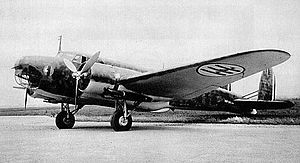Fiat BR.20
| BR.20 Cicogna | |
|---|---|
 |
|
| A Fiat BR.20 on the ground just prior to Italy's declaration of war in 1940. | |
| Role | Medium bomber |
| Manufacturer | Fiat |
| Designer | Celestino Rosatelli |
| First flight | 10 February 1936 |
| Introduction | 1936 |
| Retired | 1945 |
| Primary users |
Regia Aeronautica Japan Spain |
| Number built | Fiat BR.20 233 Fiat BR.20M 279 |
Fiat BR.20M 279
The Fiat BR.20 Cicogna (Italian: "stork") was a low-wing twin-engine medium bomber produced from the mid-1930s until the end of World War II by the Turin firm. When it entered service in 1936 it was the first all-metal Italian bomber and it was regarded as one of the most modern medium bombers in the world. It had its baptism of fire in summer 1937, with Aviazione Legionaria, during the Spanish Civil War, when it formed the backbone of Nationalist bombing operations along with the Heinkel He 111. It was then used successfully by the Japanese during the Second Sino-Japanese War. When Italy entered war in 1940, the BR.20 was the standard medium bomber of the Regia Aeronautica, but was approaching obsolescence. By 1942, it was mostly used for maritime patrol and operational training for bomber crews. More than 500 were produced before the end of the war.
In 1934, the Regia Aeronautica requested Italian aviation manufacturers to submit proposals for a new medium bomber; the specifications called for speeds of 330 km/h (205 mph) at 4,500 m (15,000 ft) and 385 km/h (239 mph) at 5,000 m (16,400 ft), a 1,000 km (620 mi) range and 1,200 kg (2,600 lb) bombload. Piaggio, Macchi, Breda, Caproni and Fiat offered aircraft that mainly exceeded the speed requirements, but not range, and not all exhibited satisfactory flight characteristics or reliability. Accepted among the successful proposals, together with the trimotor Savoia-Marchetti SM.79 and Cant Z.1007, was the BR.20 Cicogna designed by Celestino Rosatelli, thus gaining the prefix BR, (for "Bombardiere Rosatelli").
...
Wikipedia
